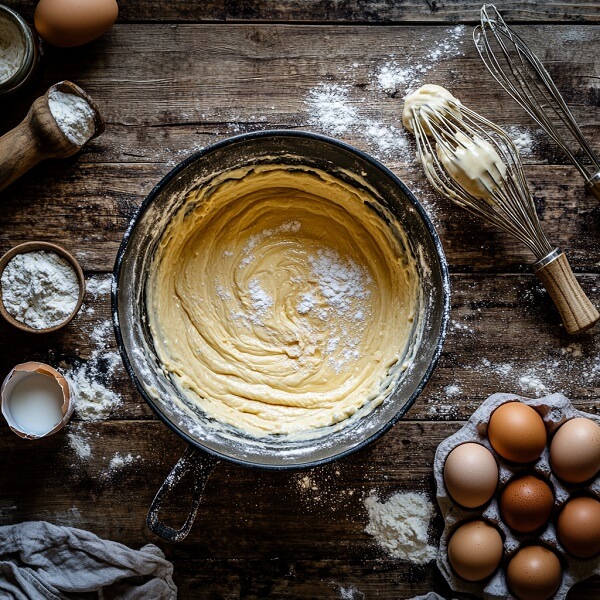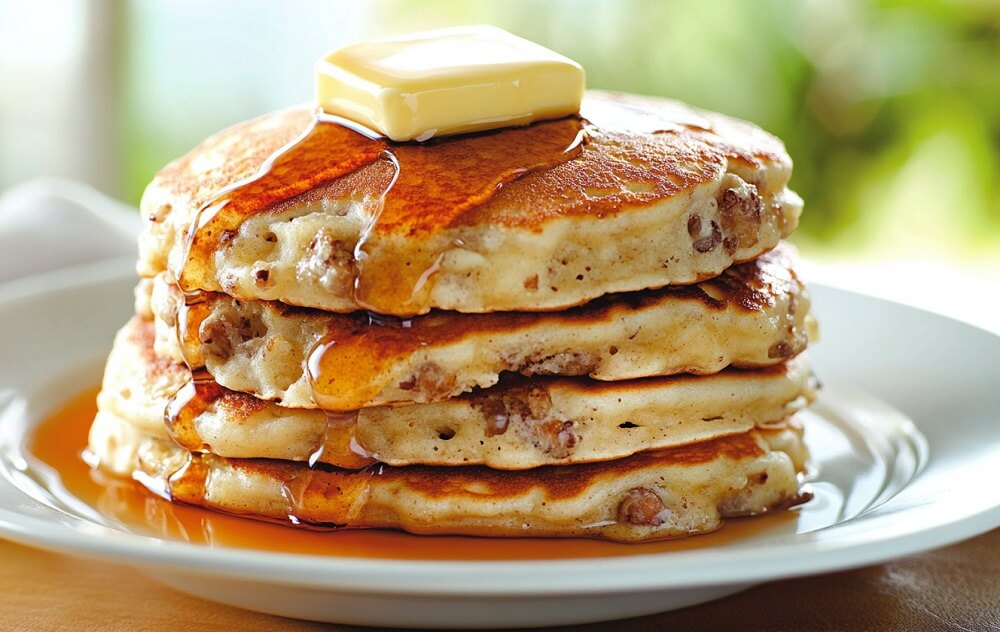Adding too many eggs to your pancake batter can lead to chewy or dense pancakes. Learn how eggs affect texture and tips for perfectly fluffy pancakes.
Pancake-Making Basics
- Start with a balanced mix of ingredients: flour, eggs, milk, and a leavening agent like baking powder.
- Mix gently to avoid overworking the batter, which can lead to tough pancakes.
- Use a non-stick pan or griddle at medium heat for even cooking.
A crucial element in this balance is the number of eggs used in the recipe. Eggs play a vital role in:
- Binding ingredients together, ensuring the batter holds its shape.
- Adding moisture for a soft and tender bite.
- Contributing to the pancake’s fluffiness and structure.
However, it’s important not to overdo it. Adding too many eggs can drastically change the texture, flavor, and even the appearance of your pancakes. By carefully measuring and understanding each ingredient’s role, you can create pancakes that are light, fluffy, and delicious every time.
The Role of Eggs in Pancake Batter
Eggs are a key ingredient in pancake batter, contributing significantly to the texture, structure, and overall success of the final product. Understanding their role can help you achieve the perfect balance in your pancakes.
How Eggs Contribute to Pancakes
- Binding Ingredients
- Eggs act as a natural binder, holding the flour, liquid, and other ingredients together.
- This ensures the batter stays cohesive and doesn’t fall apart during cooking.
- Adding Moisture
- Eggs contain both water and fat, which add moisture to the batter.
- This keeps the pancakes soft and prevents them from becoming dry or crumbly.
- Providing Structure and Fluffiness
- The proteins in eggs coagulate when heated, forming a network that provides the pancake’s structure.
- This is essential for creating pancakes that are both stable and fluffy.
The Science Behind Protein Coagulation
When eggs are cooked, their proteins undergo a process called denaturation. This involves:
- The unraveling of protein molecules, which then link together to form a new structure.
- This new structure traps air and creates a light, airy texture in the pancake.
However, too much egg can cause an overly dense and rubbery texture. The proteins may coagulate excessively, reducing the pancake’s fluffiness and making it less enjoyable to eat.
By understanding the scientific role of eggs, you can tweak your pancake recipe to achieve the perfect texture every time. Eggs are essential, but like all ingredients, they must be used in balance.

What Happens If You Put Too Much Egg in Pancakes?
While eggs are essential for making pancakes, adding too many can significantly alter the final product. The balance of ingredients is crucial, and when the egg-to-flour ratio skews too high, it can lead to several noticeable changes.
Changes in Texture
- Excessively Dense or Rubbery Pancakes
- The proteins in eggs coagulate as they cook, contributing to the pancake’s structure.
- When there are too many eggs, the pancake becomes overly firm, resulting in a dense or rubbery texture.
- This texture can feel heavy and less enjoyable compared to the light, fluffy pancakes most people prefer.
Altered Taste
- Strong Eggy Flavor
- Eggs have a distinct taste that can become overpowering if too many are used.
- Instead of a subtle enhancement, the pancakes may taste more like an omelet or custard, which might not appeal to everyone.
Cooking Issues
- Difficulty Achieving a Consistent Cook
- Pancakes with excess egg may cook unevenly because the batter becomes thicker and takes longer to set.
- The edges might cook faster while the center remains undercooked, making it harder to achieve a golden-brown pancake.
Visual Appearance
- Possible Yellowish Tint
- Extra eggs can alter the batter’s color, resulting in a more pronounced yellow hue.
- While this doesn’t affect the taste directly, it can make the pancakes look less appetizing, especially if they appear closer to scrambled eggs than a fluffy breakfast treat.
Pancake Variations with Extra Eggs
While adding too many eggs can disrupt a traditional pancake recipe, there are scenarios where extra eggs can enhance certain variations. By understanding how to adjust other ingredients, you can turn extra eggs into a feature rather than a flaw.
When Adding Extra Eggs Might Work
- Crepe-Style Pancakes
- Crepes naturally call for a higher egg-to-flour ratio compared to traditional pancakes.
- The additional eggs create a thinner, more elastic batter, perfect for the delicate and flexible texture needed for crepes.
- These pancakes are ideal for rolling or folding with sweet or savory fillings.
- Protein-Packed Breakfast Pancakes
- Extra eggs can increase the protein content, making the pancakes a more filling and nutritious breakfast option.
- Fitness enthusiasts or those seeking a high-protein diet may enjoy this variation.
- Adding complementary ingredients like oats, bananas, or protein powder can balance the batter and enhance its flavor profile.
Adjusting Other Ingredients to Balance the Batter
If you’re intentionally adding extra eggs, it’s essential to tweak the other ingredients to maintain the right consistency and taste:
- Increase the flour: Helps to counteract the runniness and density caused by the eggs.
- Add more milk or liquid: Keeps the batter pourable and prevents it from becoming too thick.
- Enhance leavening agents: Baking powder or baking soda ensures the pancakes still rise and remain fluffy.
By adapting the recipe, extra eggs can open the door to creative pancake variations rather than creating a kitchen mishap. These approaches ensure you can enjoy both classic and unique pancakes that suit your taste and dietary needs.
Troubleshooting Pancake Batter
Accidentally adding too many eggs to pancake batter can result in an undesirable texture and flavor. The good news is that there are ways to identify and fix the problem to bring balance back to your batter.
Identifying When You’ve Added Too Much Egg
- The batter appears unusually yellow or glossy.
- The consistency is overly runny or sticky, making it difficult to pour evenly.
- Pancakes turn out dense, rubbery, or taste excessively “eggy.”
- They may also cook unevenly, with centers remaining underdone while edges brown too quickly.
If you notice these signs, it’s time to troubleshoot.
How to Fix Over-Egged Batter
- Add More Flour or Liquid
- Adding extra flour helps to balance the egg content and restore the proper thickness to the batter.
- To maintain the right consistency, you may need to add a splash of milk or water after adding flour. Mix gently to avoid overworking the batter.
- Incorporate Leavening Agents
- Extra eggs can weigh down the batter, so adding a bit more baking powder or baking soda can help pancakes rise.
- Use about 1/4 teaspoon for each egg added beyond the recipe’s recommendation. This adjustment will ensure fluffiness.
- Taste and Adjust Flavor
- Extra eggs may affect the flavor balance. A pinch of sugar or vanilla extract can help neutralize an overpowering egg taste.
By making these simple adjustments, you can rescue your pancake batter and enjoy delicious results without wasting ingredients. Pancake-making is as much about experimentation as it is about precision, so don’t be afraid to tweak and taste!
Comparing Recipes with Different Egg Ratios
Pancake recipes vary widely depending on the desired texture, flavor, and appearance. One key variable is the egg-to-flour ratio, which significantly influences the final product. Understanding this balance allows you to tailor your pancakes to your preferences.
Analysis of Classic Pancake Recipes
- Most classic pancake recipes use a ratio of 1 egg per cup of flour.
- This balance creates pancakes that are light and fluffy with a mild flavor.
- Recipes designed for thinner, crepe-like pancakes often call for 2-3 eggs per cup of flour, resulting in a softer and more elastic texture.
- On the other hand, protein-rich recipes may include 2 eggs per cup of flour to enhance structure and nutritional content.
Experimenting with Different Egg-to-Flour Ratios
- Lower Egg Content (0.5 eggs per cup of flour):
- Produces pancakes that are softer but less cohesive.
- Works well with vegan or low-egg recipes that rely on alternative binders like bananas or flaxseed.
- Higher Egg Content (2+ eggs per cup of flour):
- Results in denser, more structured pancakes.
- This ratio is ideal for crepes or protein-packed variations but may be less appealing for fluffy pancake enthusiasts.
Impact on Taste, Texture, and Appearance
- Taste:
- Higher egg content adds a richer, slightly eggy flavor, while fewer eggs result in a more neutral taste.
- Texture:
- More eggs create a firmer and slightly rubbery texture.
- Fewer eggs lead to softer but less structured pancakes.
- Appearance:
- Pancakes with higher egg content may have a glossy, yellowish tint.
- Lower egg ratios produce a paler, softer pancake.
Experimenting with these ratios can help you discover your ideal pancake style. By tweaking the ingredients, you can craft pancakes that range from airy and light to rich and hearty, suiting any craving or dietary need.
FAQs
What Happens If I Forget Eggs in Pancakes?
- Without eggs, pancakes may lack structure and fall apart easily.
- They might also be less fluffy and have a denser texture.
- You can still make them work by using substitutes like bananas, applesauce, or flaxseed.
Can I Substitute Eggs in Pancake Recipes?
- Yes, there are several effective substitutes for eggs in pancakes:
- Mashed bananas: Adds sweetness and moisture.
- Applesauce: Provides a neutral flavor and binds ingredients.
- Flaxseed or chia seeds mixed with water: A great option for vegans.
- Yogurt or buttermilk: Adds richness and moisture.
- Use approximately 1/4 cup of a substitute for each egg.
How Many Eggs Should I Use for Fluffy Pancakes?
- Typically, 1 egg per cup of flour is ideal for achieving fluffy pancakes.
- For thicker or slightly denser pancakes, you can add a second egg, but balance it with more flour or liquid to avoid heaviness.
What Can I Do If I’ve Already Added Too Much Egg?
- Balance the batter by adding more flour or liquid to restore the right consistency.
- Enhance fluffiness with additional baking powder or baking soda.
- Adjust the flavor with a splash of vanilla or sugar to reduce the eggy taste.
These adjustments and tips can help you master any pancake situation, ensuring delicious results every time!
Conclusion
Creating the perfect pancake is as much an art as it is a science. A balanced combination of ingredients, especially the proper use of eggs, is key to achieving pancakes that are fluffy, flavorful, and visually appealing. Understanding how each ingredient contributes to the batter can help you fine-tune your recipe for success.
Eggs, in particular, play a vital role in binding, adding moisture, and creating structure. However, using too many can lead to dense, rubbery pancakes with an overpowering eggy flavor. Striking the right egg-to-flour ratio ensures your pancakes are light and evenly cooked, with a taste that complements rather than dominates.
While precision matters, don’t hesitate to experiment. Whether you’re adjusting the egg ratio for a protein-packed breakfast or trying crepe-style pancakes, maintaining balance is essential. When trying new variations, start with small changes and make note of how they impact texture and flavor.
For consistently perfect pancakes, remember these final tips:
- Measure your ingredients carefully.
- Mix gently to avoid overworking the batter.
- Adjust with flour, liquid, or leavening agents when experimenting with egg ratios.
By combining knowledge with creativity, you can master the art of pancake-making and enjoy a delicious breakfast that suits your taste every time. So grab your skillet, experiment boldly, and savor the satisfaction of homemade pancakes done right!

